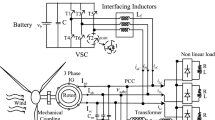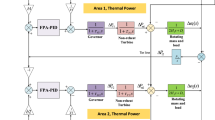Abstract
In this article, disrupted oppositional learned gravitational search algorithm (DOGSA)-optimized sliding mode control (SMC) is proposed for the load frequency regulation problem in deregulated power system including flexible alternating current transmission system devices, namely thyristor-controlled series capacitor (TCSC) and superconducting magnetic energy storage (SMES) without and with doubly fed induction generator (DFIG) wind turbine. Initially, the performance of the proposed control scheme is compared with genetic algorithm-tuned integral controller reported in the literature for two-area interconnected power system with TCSC in tie-line under deregulated environment. Further, the SMES unit is also considered in one of the areas and the system performance is analyzed and found to be better with the combination of optimized SMC and TCSC–SMES for unilateral, bilateral as well as contract violation cases in comparison with system with optimal SMC and TCSC and also with the controller reported in the literature. The potential of the proposed schemes is further analyzed and studied in the presence of nonlinear constraints, namely generation rate constraint, governor deadband and time delay which are present in the real-time power system. From the simulation results, it is deduced that the optimal SMC-generated control signal eliminates the chattering problem in the controller output. Also, the combination of TCSC and SMES improves the transient performance of the system. Thus, the frequency regulation in deregulated power system has been performed using the DOGSA-tuned SMC and also investigated the coordinated action of TCSC–SMES with inclusion of DFIG wind turbine in both the control areas of the system.


















Similar content being viewed by others
References
Donde V, Pai MA, Hiskens IA (2001) Simulation and optimization in an AGC system after deregulation. IEEE Trans Power Syst 16:481–489. doi:10.1109/59.932285
Saikia LC, Nanda J, Mishra S (2011) Performance comparison of several classical controllers in AGC for multi-area interconnected thermal system. Int J Electr Power 33:394–401. doi:10.1016/j.ijepes.2010.08.036
Shayeghi H, Shayanfar HA (2006) Application of ANN technique based on μ-synthesis to load frequency control of interconnected power system. Int J Electr Power 28:503–511. doi:10.1016/j.ijepes.2006.02.012
Shayeghi H, Shayanfar HA, Jalili A (2006) Multi-stage fuzzy PID power system automatic generation controller in deregulated environments. Energy Convers Manag 47:2829–2845. doi:10.1016/j.enconman.2006.03.031
Ibraheem Kumar P, Hasan N, Singh Y (2012) Optimal automatic generation control of interconnected power system with asynchronous tie-lines under deregulated environment. Electr Power Compon Syst 40:1208–1228. doi:10.1080/15325008.2012.682252
Huddar A, Kulkarni PS (2008) A robust method of tuning the feedback gains of a variable structure load frequency controller using genetic algorithm optimization. Electr Power Compon Syst 36:1351–1368. doi:10.1080/15325000802258380
Al-Hamouz Z, Al-Duwaish H, Al-Musabi N (2011) Optimal design of a sliding mode AGC controller: application to a nonlinear interconnected model. Electr Power Syst Res 81:1403–1409. doi:10.1016/j.epsr.2011.02.004
Sahu RK, Panda S, Padhan S (2014) Optimal gravitational search algorithm for automatic generation control of interconnected power systems. Ain Shams Eng J 5:721–733. doi:10.1016/j.asej.2014.02.004
Shiva CK, Mukherjee V (2015) Automatic generation control of interconnected power system for robust decentralized random load disturbances using a novel quasi-oppositional harmony search algorithm. Int J Electr Power 73:991–1001. doi:10.1016/j.ijepes.2015.06.016
Debbarma S, Saikia LC, Sinha N (2014) Solution to automatic generation control problem using firefly algorithm optimized IλDμ controller. ISA Trans 53:358–366. doi:10.1016/j.isatra.2013.09.019
Dahiya P, Sharma V, Sharma RN (2015) Optimal generation control of interconnected power system including DFIG-based wind turbine. IETE J Res 61:285–299. doi:10.1080/03772063.2015.1019579
Rashedi E, Nezamabadi-pour H, Saryazdi S (2009) GSA: a gravitational search algorithm. Inf Sci 179:2232–2248. doi:10.1016/j.ins.2009.03.004
Rahnamayan S, Tizhoosh HR, Salama MMA (2007) A novel population initialization method for accelerating evolutionary algorithms. Comput Math Appl 53:1605–1614. doi:10.1016/j.camwa.2006.07.013
Sarafrazi S, Nezamabadi-Pour H, Saryazdi S (2011) Disruption: a new operator in gravitational search algorithm. Sci Iran 18:539–548. doi:10.1016/j.scient.2011.04.003
Dahiya P, Sharma V, Naresh R (2015) Solution approach to automatic generation control problem using hybridized gravitational search algorithm optimized PID and FOPID controllers. Adv Electr Comput Eng 15:23–34. doi:10.4316/AECE.2015.02004
Gouthamkumar N, Sharma V, Naresh R (2016) Hybridized gravitational search algorithm for short-term hydrothermal scheduling. IETE J Res 62:468–478. doi:10.1080/03772063.2015.1083904
Mohamed TH, Morel J, Bevrani H, Hassan AA, Mohamed YS, Hiyama T (2012) Decentralized model predictive-based load-frequency control in an interconnected power system concerning wind turbines. IEEJ Trans Electr Electron Eng 7:487–494. doi:10.1002/tee.21762
Mohanty B (2015) TLBO optimized sliding mode controller for multi-area multi-source nonlinear interconnected AGC system. Int J Electr Power 73:872–881. doi:10.1016/j.ijepes.2015.06.013
Utkin V, Guldner J, Shi J (2009) Sliding mode control in electro-mechanical systems. CRC Press, Taylor & Francis Group, pp 1–45
Ahmadi R, Sheikholeslami A, Niaki AN, Ranjbar A (2015) Dynamic participation of doubly fed induction generators in multi-control area load frequency control. Int Trans Electr Energy Syst 25:1130–1147. doi:10.1002/etep.1891
Ibraheem Niazi KR, Sharma G (2015) Study on dynamic participation of wind turbines in automatic generation control of power systems. Electr Power Compon Syst 43:44–55. doi:10.1080/15325008.2014.963266
Sharma G, Nasiruddin I, Niazi KR (2015) Optimal automatic generation control of asynchronous power systems using output feedback control strategy with dynamic participation of wind turbines. Electr Power Compon Syst 43:384–398. doi:10.1080/15325008.2014.949916
Mi Y, Fu Y, Li D, Wang C, Loh PC, Wang P (2016) The sliding mode load frequency control for hybrid power system based on disturbance observer. Int J Electr Power 74:446–452. doi:10.1016/j.ijepes.2015.07.014
Morsali J, Zare K, Hagh MT (2016) Performance comparison of TCSC with TCPS and SSSC controllers in AGC of realistic interconnected multi-source power system. Ain Shams Eng J 7:143–158. doi:10.1016/j.asej.2015.11.012
Gorripotu TS, Sahu RK, Panda S (2015) AGC of a multi-area power system under deregulated environment using redox flow batteries and interline power flow controller. Eng Sci Technol Int J 18:555–578. doi:10.1016/j.jestch.2015.04.002
Deepak M, Abraham RJ (2015) Load following in a deregulated power system with thyristor controlled series compensator. Int J Electr Power 65:136–145. doi:10.1016/j.ijepes.2014.09.038
Sahu RK, Gorripotu TS, Panda S (2015) A hybrid DE–PS algorithm for load frequency control under deregulated power system with UPFC and RFB. Ain Shams Eng J 6:893–911. doi:10.1016/j.asej.2015.03.011
Padhan S, Sahu RK, Panda S (2014) Automatic generation control with thyristor controlled series compensator including superconducting magnetic energy storage units. Ain Shams Eng J 5:759–774. doi:10.1016/j.asej.2014.03.011
Bhatt P, Roy R, Ghoshal SP (2010) GA/particle swarm intelligence based optimization of two specific varieties of controller devices applied to two-area multi-units automatic generation control. Int J Electr Power 32:299–310. doi:10.1016/j.ijepes.2009.09.004
Dahiya P, Sharma V, Naresh R (2016) Automatic generation control using disrupted oppositional based gravitational search algorithm optimised sliding mode controller under deregulated environment. IET Gener Transm Distrib 10:3995–4005. doi:10.1049/iet-gtd.2016.0175
Golpira H, Bevrani H, Golpira H (2011) Application of GA optimization for automatic generation control design in an interconnected power system. Energy Convers Manag 52:2247–2255. doi:10.1016/j.enconman.2011.01.010
Yilmaz AS, Ozer Z (2009) Pitch angle control in wind turbines above the rated wind speed by multi-layer perceptron and radial basis function neural networks. Expert Syst Appl 36:9767–9775. doi:10.1016/j.eswa.2009.02.014
Al-Hamouz Z, Al-Duwaish HN, Al-Musabi NA (2011) Particle swarm optimizing sliding mode controller. US Patent 2011/0257800 A1
Dahiya P, Sharma V (2017) Hybridized gravitational search algorithm tuned sliding mode controller design for load frequency control system with doubly fed induction generator wind turbine. Optim Control Appl Methods. doi:10.1002/oca.2305
Acknowledgements
This work is supported by Council of Scientific & Industrial Research, New Delhi, India, under Research and Development Project Grant 22(0692)/15/EMR-II.
Author information
Authors and Affiliations
Corresponding author
Ethics declarations
Conflict of interest
Dr. Veena Sharma has received research grants from Council of Scientific & Industrial Research, New Delhi, India.
Research involving human participants and/or animals
All procedures performed in studies involving human participants were in accordance with the ethical standards of the institutional and/or national research committee and with the 1964 Helsinki Declaration and its later amendments or comparable ethical standards. This paper does not contain any studies with animals performed by any of the authors.
Informed consent
Informed consent was obtained from all individual participants included in the study.
Rights and permissions
About this article
Cite this article
Dahiya, P., Sharma, V. & Naresh, R. Optimal sliding mode control for frequency regulation in deregulated power systems with DFIG-based wind turbine and TCSC–SMES. Neural Comput & Applic 31, 3039–3056 (2019). https://doi.org/10.1007/s00521-017-3250-y
Received:
Accepted:
Published:
Issue Date:
DOI: https://doi.org/10.1007/s00521-017-3250-y




